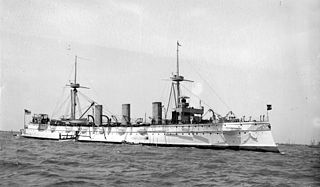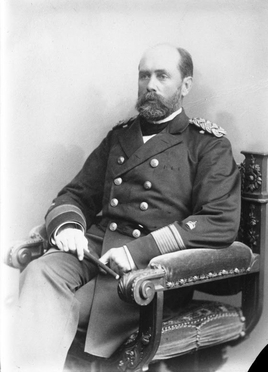
SMS Friedrich der Grosse was an ironclad turret ship built for the German Kaiserliche Marine. She was the second of three Preussen-class ironclads, in addition to her two sister-ships Preussen and Grosser Kurfürst. Named for Frederick the Great, she was laid down at the Imperial Dockyard in Kiel in 1871 and completed in 1877. Her main battery of four 26 cm (10 in) guns was mounted in a pair of twin gun turrets amidships.

SMS Brandenburg was the lead ship of the Brandenburg-class pre-dreadnought battleships, which included Kurfürst Friedrich Wilhelm, Weissenburg, and Wörth, built for the German Kaiserliche Marine in the early 1890s. She was the first pre-dreadnought built for the German Navy; earlier, the navy had only built coastal defense ships and armored frigates. The ship was laid down at the AG Vulcan dockyard in 1890, launched on 21 September 1891, and commissioned into the German Navy on 19 November 1893. Brandenburg and her three sisters were unique for their time in that they carried six heavy guns instead of the four that were standard in other navies. She was named after the Province of Brandenburg.

SMS Sachsen was the lead ship of her class of four ironclads of the German Kaiserliche Marine. Her sisterships were Bayern, Württemberg, and Baden. Sachsen was built in the AG Vulcan shipyard in Stettin. She was laid down in April 1875, launched on 21 July 1877, and commissioned on 21 October 1878. The ship was armed with a main battery of six 26 cm (10.2 in) guns in individual open mounts.

SMS Kaiser was the lead ship of the Kaiser-class ironclads; SMS Deutschland was her sister ship. Named for the title "Kaiser", held by the leader of the then newly created German Empire, the ship was laid down in the Samuda Brothers shipyard in London in 1871. The ship was launched in March 1874 and commissioned into the German fleet in February 1875. Kaiser mounted a main battery of eight 26 cm (10.2 in) guns in a central battery amidships.

SMS Kaiserin Augusta was a unique protected cruiser, built for the German Kaiserliche Marine in the early 1890s. Named for Empress Augusta, who died in January 1890, she was laid down in 1890, launched in January 1892, and completed in November of that year. Owing to budgetary restrictions, Kaiserin Augusta was designed to fill both fleet scout and colonial cruiser roles. The ship was initially armed with a main battery of four 15 cm (5.9 in) and eight 10.5 cm (4.1 in) guns, which by 1896 was replaced with twelve new model 15 cm guns. She was the first ship in the German Navy to feature a three-shaft propeller arrangement.

The Kiautschou Bay Leased Territory was a German leased territory in Imperial and Early Republican China from 1898 to 1914. Covering an area of 552 km2 (213 sq mi), it centered on Kiautschou Bay on the southern coast of the Shandong Peninsula. The administrative center was at Tsingtau (Qingdao). It was operated by the East Asia Squadron of the Imperial German Navy. The Russian Empire resented the German move as an infringement on Russian ambitions in the region.

Ernst Otto von Diederichs was a German admiral of the Prussian Navy who served both the Kingdom of Prussia and the German Empire. He was the first governor of the German Jiaozhou Bay concession in China.

SMS Gefion was an unprotected cruiser of the German Kaiserliche Marine, the last ship of the type built in Germany. She was laid down in March 1892, launched in March 1893, and completed in June 1895 after lengthy trials and repairs. The cruiser was named after the earlier sail frigate Gefion, which had been named for the goddess Gefjon of Norse mythology. Intended for service in the German colonial empire and as a fleet scout, Gefion was armed with a main battery of ten 10.5-centimeter (4.1 in) guns, had a top speed in excess of 19.5 knots, and could steam for 3,500 nautical miles, the longest range of any German warship at the time. Nevertheless, the conflicting requirements necessary for a fleet scout and an overseas cruiser produced an unsuccessful design, and Gefion was rapidly replaced in both roles by the newer Gazelle class of light cruisers.

SMS Irene was a protected cruiser or Kreuzerkorvette of the German Imperial Navy and the lead ship of the Irene class. She had one sister, Prinzess Wilhelm; the two ships were the first protected cruisers built by the German Navy. Irene was laid down in 1886 at the AG Vulcan shipyard in Stettin, launched in July 1887, and commissioned into the fleet in May 1888. The cruiser was named after Princess Irene of Hesse and by Rhine, sister-in-law of Kaiser Wilhem II. As built, the ship was armed with a main battery of fourteen 15 cm (5.9 in) guns and had a top speed of 18 knots.

The Irene class was a class of protected cruisers built by the Imperial German Navy in the late 1880s. The class comprised two ships, Irene and Prinzess Wilhelm; they were the first protected cruisers built by the German Navy. As built, the ships were armed with a main battery of fourteen 15 cm (5.9 in) guns and had a top speed of 18 knots. They were modernized in 1899–1905, and their armament was upgraded with new, quick-firing guns.

SMS Stein was a Bismarck-class corvette built for the German Imperial Navy in the late 1870s. The ship was named after the Prussian statesman Heinrich Friedrich Karl vom und zum Stein. She was the sixth member of the class, which included five other vessels. The Bismarck-class corvettes were ordered as part of a major naval construction program in the early 1870s, and she was designed to serve as a fleet scout and on extended tours in Germany's colonial empire. Stein was laid down in 1878, launched in September 1879, and was commissioned into the fleet in October 1880. She was armed with a battery of twelve 15 cm (5.9 in) guns and had a full ship rig to supplement her steam engine on long cruises abroad.

SMS Baden was one of four Sachsen-class armored frigates of the German Kaiserliche Marine. Her sister ships were Sachsen, Bayern, and Württemberg. Baden was built in the Kaiserliche Marine in Kiel from 1876 to 1883. The ship was commissioned into the Imperial Navy in September 1883. She was armed with a main battery of six 26 cm (10.2 in) guns in two open barbettes.

SMS Zieten was the first torpedo-armed aviso built for the Imperial German Navy. She was built in Britain in 1875–1876, and was the last major warship built for Germany by a foreign shipyard. Ordered as a testbed for the new Whitehead torpedo, Zieten was armed with a pair of 38 cm (15 in) torpedo tubes, and was capable of a top speed of 16 knots, making her the fastest ship in the German fleet at the time. Zieten was the first torpedo-armed vessel in a series of avisos that ultimately developed into the first light cruisers. In addition to her impact in German warship design, Zieten also influenced numerous other navies, who built dozens of similar avisos and torpedo vessels of their own.

SMS Blücher was a Bismarck-class corvette built for the German Kaiserliche Marine in the late 1870s. The Bismarck-class corvettes were ordered as part of a major naval construction program in the early 1870s, and she was designed to serve as a fleet scout and on extended tours in Germany's colonial empire. Blücher was laid down in March 1876, launched in September 1877, and was commissioned into the fleet in late 1878. Unlike her sister ships, Blücher was converted shortly after entering service into a torpedo training ship to experiment with the new self-propelled torpedoes and develop German torpedo doctrine.

SMS Blitz was an aviso of the German Kaiserliche Marine built in the early 1880s. She was the lead ship of her class, which included one other vessel, SMS Pfeil. Her primary offensive armament consisted of a bow-mounted torpedo tube, and she was armed with a battery of light guns to defend herself against torpedo boats, a sign of the growing importance of torpedoes as effective weapons in the period. The Blitz class featured a number of innovations in German warship design: they were the first steel hulled warships and the first cruiser-type ships to discard traditional sailing rigs.

SMS Marie was a member of the Carola class of steam corvettes built for the German Kaiserliche Marine in the 1880s. Intended for service in the German colonial empire, the ship was designed with a combination of steam and sail power for extended range, and was equipped with a battery of ten 15-centimeter (5.9 in) guns. Marie was laid down at the Reiherstieg AG shipyard of Hamburg in 1880, the first Imperial German warship built in the city. She was launched in August 1881. In May, 1883, she was completed and commissioned into the fleet. The namesake was Princess Marie of Schwarzburg-Rudolstadt, who married Frederick Francis II, Grand Duke of Mecklenburg-Schwerin in 1868.

SMS Alexandrine was a member of the Carola class of steam corvettes built for the German Kaiserliche Marine in the 1880s. Intended for service in the German colonial empire, the ship was designed with a combination of steam and sail power for extended range, and was equipped with a battery of ten 15-centimeter (5.9 in) guns. Alexandrine was laid down at the Kaiserliche Werft in Kiel in 1882, she was launched in February 1885, and she was completed in October 1886 before being laid up after completing sea trials.

SMS Arcona was a member of the Carola class of steam corvettes built for the German Kaiserliche Marine in the 1880s. Intended for service in the German colonial empire, the ship was designed with a combination of steam and sail power for extended range, and was equipped with a battery of ten 15-centimeter (5.9 in) guns. Arcona was laid down at the Kaiserliche Werft in Danzig in 1881, she was launched in May 1885, and she was completed in December 1886.

The Carola class was a group of six screw corvettes built by the German Kaiserliche Marine in the late 1870s and 1880s. The class comprised Carola, the lead ship, Olga, Marie, Sophie, Alexandrine, and Arcona. They were ordered to replace older sailing vessels that were no longer sufficient to protect German interests around the world. Intended for service in the German colonial empire, the ships were designed with a combination of steam and sail power for extended cruising range, and they were equipped with a battery of ten 15-centimeter (5.9 in) guns. Relying primarily on sail power for their long-range deployments, the ships were obsolescent before construction began.

SMS Prinz Adalbert was a steam corvette of the German Kaiserliche Marine, the second and final member of the Leipzig class. She was laid down in 1875 at the AG Vulcan shipyard in Stettin, was launched in June 1876, and was commissioned into the fleet in August 1877. Originally named Sedan after the Battle of Sedan of the Franco-Prussian War, she was renamed Prinz Adalbert to avoid antagonizing France in 1878, less than a decade after the battle.
























